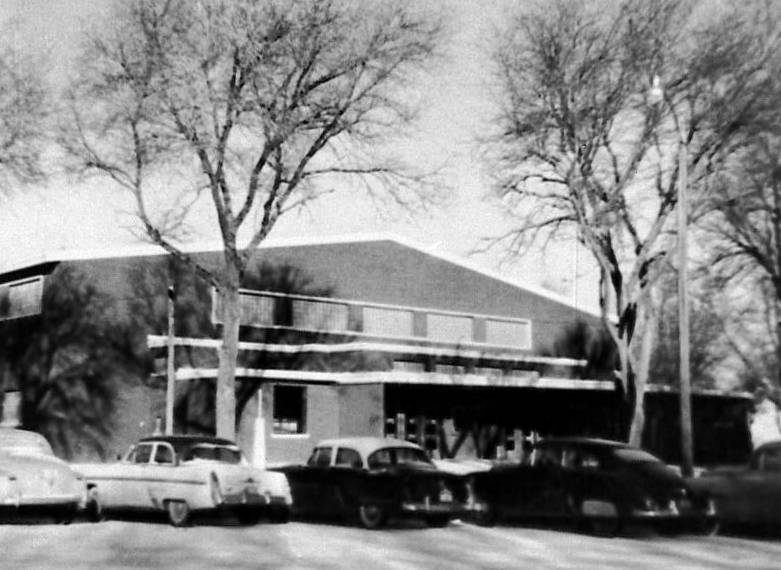



SOURCES: National Constitution Center; Colonial Williamsburg; Huffington Post; A History of Barbering; archives of the Lakin papers, and Museum archives.




SOURCES: National Constitution Center; Colonial Williamsburg; Huffington Post; A History of Barbering; archives of the Lakin papers, and Museum archives.
Our first “Night at the Museum” was a success! Thank you to everyone who came out October 17 and joined us for an evening of history and fun! For those who didn’t make it, never fear! We plan to come back bigger and better next year! A huge shout-out to all our storytellers and helpers …. couldn’t have done it without you!










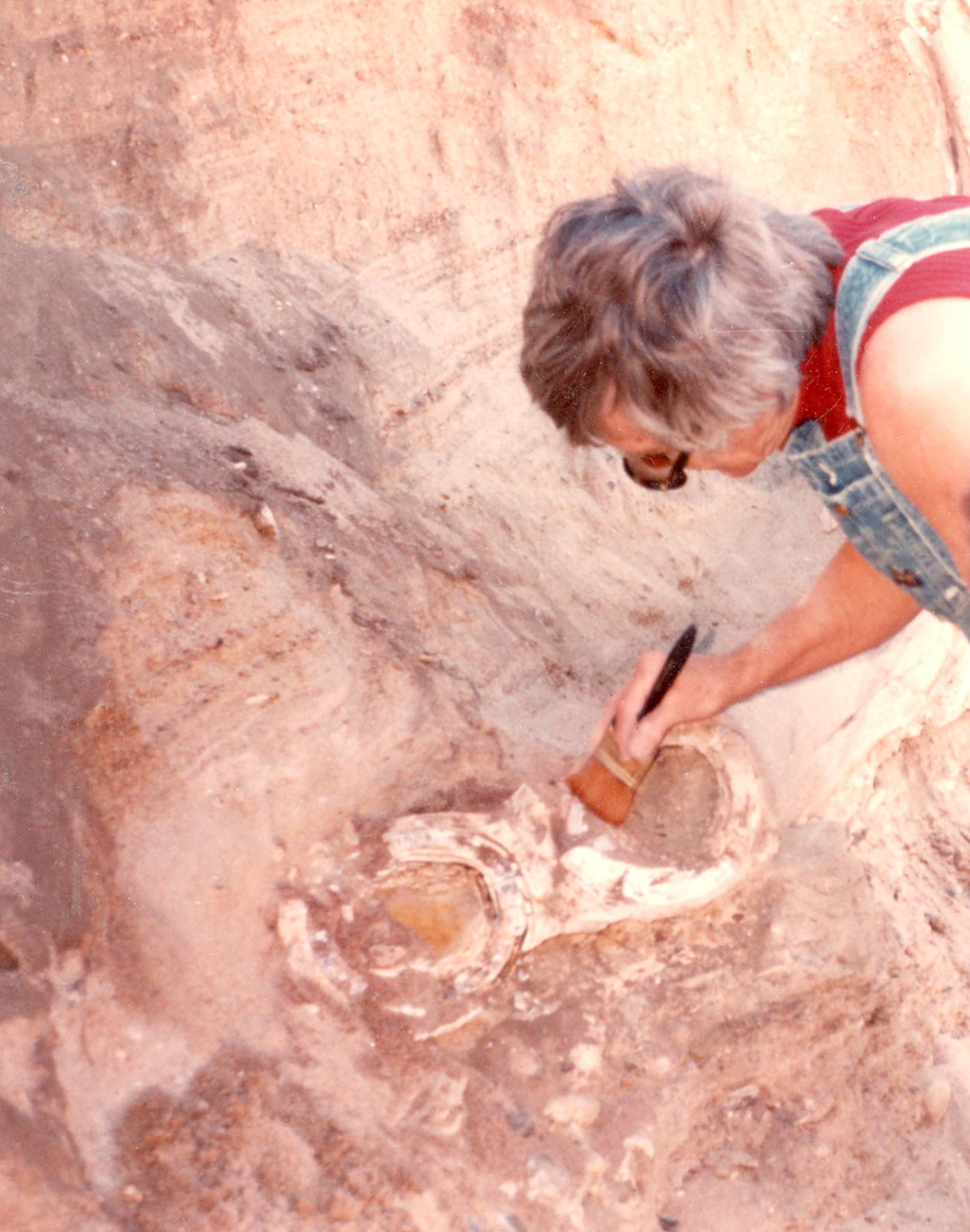



The history of the house on the southwest corner of Buffalo and Washington in Lakin harkens back to the heydays of Hartland and one of Kearny County’s earliest businessmen. Many locals associate the 209 N. Buffalo location with Leon and Leona Davis who operated Davis Funeral Home out of their residence for more than 30 years, but it was another undertaker who owned the property first.

Corporal Edmond Strong Snow, a Civil War veteran, grew up on his father’s farm in Ashtabula County, Ohio and finished his education in the Grand River Institute at Austinburg, OH. Snow enlisted at the age of 19 in February of 1863 with Company C of the 60th Ohio Infantry. Two months later, Snow found himself under fire at the bloody Battle of the Wilderness, the first stage of a major Union offensive toward the Confederate capital of Richmond. Snow’s regiment bore the brunt of much of the hard fighting that followed in Virginia until the close of the Civil War. While he personally escaped all enemy bullets, Snow was wounded when a tree fell on him.
After the war, he went to Dearborn, Michigan with the intention to study medicine alongside his uncle, but ridding his mind of the scenes of military life was impossible for Snow. He abandoned his studies and took on a variety of jobs including starting his own grocery business at Holly, Michigan. Late in the fall of 1868, he was broke and looking for a job when he spotted a “help wanted” sign in Chicago for the Union Pacific Railroad which was then in the process of constructing across the great West. He hired on to the grading outfit working all the way to Wasatch, Utah which was the end of the line. Soon after arriving there, he transferred his services to the car repair shops of the company. E.S. served as a switchman and then as a railway brakeman before becoming a freight conductor. For 10 years, Snow was a passenger conductor from Cheyenne, WY west over the different divisions but chiefly between Laramie and Green River. He was in Wyoming, Utah and Idaho altogether for 18 years.
Ed Snow moved in November 1885 to Hartland where he established a lumber yard and general merchandise business, became partner in a livery, and erected a number of buildings. The highly respected businessman was elected Hartland’s first mayor, served as a director for the Bank of Hartland and organized the Knights of Pythias there. He also started branch lumber yards at Surprise and Cincinnati, Grant County towns with fates similar to Hartland’s. While many left Hartland immediately after Lakin secured the county seat, Snow remained there but eking out a living in a dying town was difficult.
News broke in May 1895 that Snow had purchased a lot on north Main in Lakin and was moving his buildings and stock of general merchandise here from Hartland. He was open for business by the end of summer. Some of Snow’s buildings were combined to make his residence at the Buffalo and Washington location. Snow purchased the Kearny County Advocate in 1902 and dabbled for a short time in the newspaper business. In February of 1907 came the announcement that he was having an opera house erected on the southeast corner of Main and Lincoln. The concrete, fire-proof 50×100 building was to be two stories high with the top story housing Snow’s Opera House, also known as the Lakin Opera House or Snow’s Theatre. The theatre had a seating capacity of 250 and included a 14×28 stage, dressing rooms and scenery. Dances, lodge and religious meetings, graduation exercises, and festivals were held there, and local as well as traveling entertainment performed for crowds of theatre-goers. Mr. Snow’s furniture, hardware and undertaking business occupied the first floor.
His wife of 46 years, Margaret Collins Snow, passed in 1922. Edmond Snow retired the following year and traveled as much as he could until ill health prevented him from doing so. Kearny County sheriff-elect Roy Puyear and his wife moved in with Snow at his home on Buffalo Street in 1924, and Snow died in 1926. The Snows had no children, but their former home and the building which housed Snow’s Theatre still stand in Lakin. The building was and is still considered one of the best in town. According to Edmond Snow’s obituary, the structure at 122 N. Main stood as a memorial to his life and activities in Lakin. The building has housed The Agency since 1982. In recent years, the top story was renovated and an addition was built to the south to serve as the residence of The Agency’s owner, Doug Geubelle and his wife, Stacey.
SOURCES: Diggin’ Up Bones by Betty Barnes; A Standard History of Kansas and Kansans, written and compiled by William E. Connelley; History of Kearny County Vol. I; archives of The Hartland Times, Advocate and Lakin Independent; and Museum archives.




.
Doctors gave James Milton Judd six months to live, and what did he do? The 24-year-old Kentuckian moved to Kansas. After a few months in Wellington, he moved to Belle Plaine where he managed a flour mill. Judd had already outlived doctors’ expectations when he and L.B. Richardson headed to Stevens County in December 1885 to settle on some claims. Their plans were interrupted by a heavy snowstorm. The train was held up at Lakin, but there were no sleeping rooms available for the two men. When the duo inquired at the Commercial Hotel, the landlady had nothing to offer them but the floor of the hotel office to sleep on. A full-blown blizzard ensued, and the men’s finances were in dire shape by the time the snowstorm was over. They decided they had to embark on some kind of business. With a loan from some friends back east, the men negotiated the purchase of the smallest business house in Lakin and opened a confectionary. Eventually the two made enough money to repay their loans, and Richardson returned back east dissolving their business in 1889. Judd continued in the confectionary business on south Main and offered ice cream, groceries, school books, stationery, cigars, ice and more until 1906. Then his new store building went up at 111 N. Main where he sold shoes, clothing, hats, gloves, magazines and more.
Judd was one of the busiest men in Lakin from the time he arrived here. He managed the Postal Telegraph and Cable Company from 1890 to 1913, was elected probate judge in 1896, and then was elected county treasurer in 1899. Because he was an expert accountant, Judd was offered the cashier position at the Lakin State Bank in 1908, a title he held for over 31 years. In 1915, he closed his shoe store, and that same year he went into business selling automobiles and farm equipment. J. M. Judd Motor Company, located on the corner of Buffalo and Waterman, was also known as the Ford Garage and was the predecessor to Lakin Motor Company. Judd also served as the mayor of Lakin, was on the Lakin City Council and school board, and was very active in many organizations. He was the Sunday school superintendent at the Lakin Presbyterian Church, and in 1937, he was elected president of Group Nine of the Kansas Bankers Association. The Nov. 11, 1937 Kearny County Advocate praised Judd, “All recognize in him the true gentleman … he looks the part in his tall, distinguished bearing and he acts it in his quiet, almost shy, kindness and respect for others.”
Judd married Isabella Craver in 1892. Born in West Virginia, “Belle” moved to Garden City in 1886 then to Lakin in 1888. She was a charter member of the Presbyterian Church in Garden but later transferred her membership to the Lakin church. Isabella always had a deep interest and took an active part in church work and the missionary society. She was also involved with the Woman’s Christian Temperance Union, Eastern Star and Royal Neighbors. She passed in 1927.
J.M. and Isabella had two children. Son Clarence was born in 1895 but died at the age of one year and 25 days. Although born healthy, the boy became severely ill when he was cutting teeth which led to deadly complications.
Soon after little Clarence’s death, Isabella became pregnant with a daughter. Edythe Lillian Judd was born in 1897 and graduated with Lakin’s Class of 1915. She attended business college in Colorado Springs and was married there in 1927 to Ralph Stees. Stees, a veteran of World War I, had been employed by Fred Harvey of Harvey House fame both before and after the war. Ralph and Edythe made their home in Lakin, both gaining employment with the Lakin State Bank. When her father passed away, Edythe acquired J.M. Judd Motor Co. and ran the business until 1947. Like her parents, Edythe was a member of the Lakin Presbyterian Church and was also involved with Eastern Star, PEO, and the Mus-Art Club. Ralph sold real estate, served as Lakin’s mayor from 1931 until 1935, was on City Council from 1937 until 1943, and belonged to the Masonic Lodge and Order of Eastern Star. He passed in 1970 and Edythe in 1973. They had no children.
Living in Kansas must have been written in the stars for James Judd as he was born on the same day that Kansas was admitted to the Union, January 29, 1861. He lived to be 78 years old, 54 years more than doctors predicted. His and Isabella’s family home still stands on the northwest corner of Buffalo and Lincoln Streets and was once described as one of the finest residences and nicest kept within the city. According to the April 9, 1908 Advocate, J.M. Judd was the first in Lakin to install a cement sidewalk in front of his residence. Although very poor when he landed in Lakin, Judd’s work ethic and business sense led him to become one of the most prominent citizens and businessmen in town.





SOURCES: Diggin’ Up Bones by Betty Barnes; archives of The Advocate and Lakin Independent; History of Kearny County Vol. 1, and Museum archives.

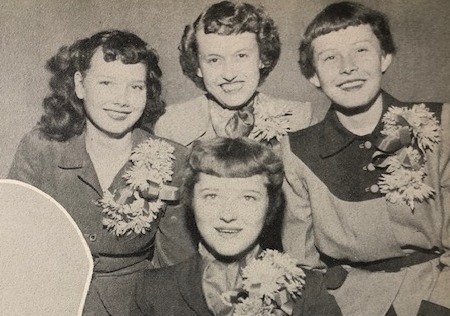









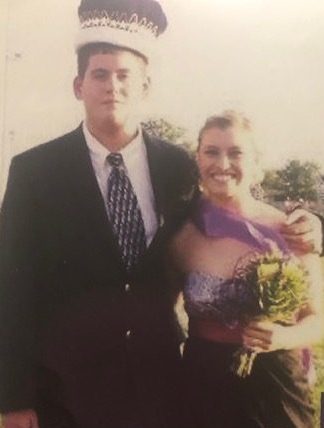


Many of Cora Holt’s former students remember her as a toe-the-line teacher, but there was more to the educator than meets the eye. Born Cora Edelene Rarden, she was a descendant of two of the earliest families in Kearny County. Her maternal great-grandfather, Joseph Dillon, was the editor of The Lakin Herald, and her grandmother, Maria Dillon Browne, earned a reputation as one of the best compositors in the state while typesetting for the paper. The Dillon family moved to Kearny County in 1879. Cora’s maternal grandfather, D. H. Browne, came to Lakin in 1880 and served many years as county clerk including during the time of the county seat wars.
D. H. and Maria Browne’s daughter Helen married James Harry Rardon in 1907. Known affectionately as Doc, Rardon had arrived in Lakin a year earlier to set up a dental office, and in 1909, he received his pharmacy certificate from the State of Kansas and purchased the drugstore here from Dr. G.C. Richards. Doc and Helen had three children: a son who died in infancy in 1908, daughter Jean born in 1909, and Cora, the baby of the family who was given the name of her paternal grandmother. News of Cora’s birth came via the Sept. 19, 1913 Advocate, “A little daughter arrived at the home of Dr. and Mrs. Rardon, Friday last, and the doctor is “wearing a smile that won’t come off.”
Doc Rardon was well-educated, well-rounded, and well-liked. He had a prowess for writing poetry, particularly love poems for his wife who he referred to as his Little Browne Hen. The wittiness and sweetness in his poetry leads one to assume that Cora grew up in a very loving and affectionate family. He sold the drugstore in 1910 and then ran drugstores elsewhere in Kansas and Missouri and was also a traveling salesman for pharmaceuticals. By 1920, the family was back living on their ranch west of Lakin while Doc continued with his salesman position.

Meanwhile, Cora grew to be both beautiful and bright. As a student at Lakin High School, she served three years on Student Council, was in charge of art in the 1931 Prairie Breeze annual, played violin in the orchestra, and participated in debate, drama, vocal, basketball and tennis. Cora was treasurer of the Girl Reserves, the predecessor to Y-Teens, and during her senior year, she was the lone female of five cheerleaders in the Kakaphony Club, the high school’s official pep club.
 While Cora was very much a traditionalist, she was also a trailblazer. At a time when most women entered the teaching profession, she instead attended Kansas University where she earned her pharmacology degree in 1935. Cora returned to Lakin and began working as a registered pharmacist in Roy Menn’s drugstore, the same drugstore that her father had previously owned in the building that houses Duncan’s Lockers. The Rardons purchased Menn’s in June of 1936, and in 1939, they bought the building at 111 N. Main (now Shorty’s II) and moved their stock there. After Doc Rardon’s death in 1942, Cora and her mother continued to operate the pharmacy until March 1945 when they sold the business to Floyd Barnes of Ulysses.
While Cora was very much a traditionalist, she was also a trailblazer. At a time when most women entered the teaching profession, she instead attended Kansas University where she earned her pharmacology degree in 1935. Cora returned to Lakin and began working as a registered pharmacist in Roy Menn’s drugstore, the same drugstore that her father had previously owned in the building that houses Duncan’s Lockers. The Rardons purchased Menn’s in June of 1936, and in 1939, they bought the building at 111 N. Main (now Shorty’s II) and moved their stock there. After Doc Rardon’s death in 1942, Cora and her mother continued to operate the pharmacy until March 1945 when they sold the business to Floyd Barnes of Ulysses.

On a Sunday afternoon in January 1945, Cora donned her mother’s wedding dress and married Edwin Holt, a well-liked prominent rancher. She gained two step-sons in the process, and in 1946, gave birth to her and Ed’s only child together, a son they named Jewell Harry after their fathers.
Catastrophe struck the young family on September 16, 1953 when Ed went to the Tate Ranch 10 miles southwest of Lakin to check cattle. When he did not return at the usual time, Cora became worried. Her neighbors, John and Elene Henderson, drove her to the ranch where they found Edwin’s body in the concrete stock tank. He had started climbing a 40-foot windmill tower to make repairs, and part of the wooden platform gave way. Ed fell backward, and according to the Hamilton County coroner, was apparently killed instantly when he struck the bottom of the tank.
Cora became a single parent and bread winner for her and her small son. She took a teaching job at Holcomb then taught at Deerfield Grade School for two years. She began her teaching career at Lakin in the fall of 1962 and taught until the end of the 1974-1975 school year. Cora served as president of the Parent-Teacher Association, was on the Kearny County Library’s board of directors when the library was built in the 1970s, taught first aid, and helped with Cub Scouts and the Red Cross. A member of the Order of the Eastern Star, Delta Kappa Gamma and the United Presbyterian Church, she also contributed stories to Vol. II of the History of Kearny County.
Cora Edelene Rardon Holt passed away in September of 1980, seven days shy of her 67th birthday. Her life was an example of perseverance and selflessness. While her students only knew Cora in her later years, the accompanying pictures reveal a very vibrant and attractive young woman who was nicknamed “Codie” by her classmates and admired for her “peppy” disposition.
SOURCES: 1931 Prairie Breeze; 1972-1973 Lakin Grade School annual; History of Kearny County Vols. I & II; Diggin’ Up Bones by Betty Barnes; archives of The Advocate, Lakin Independent, Chase Register, Kinsley Mercury and Lyons Republican; Museum archives; and photographs and archives received from the Jewell Holt Estate.
With an average enrollment of 300 students in the primary through eighth grades and a steadily increasing population, Lakin’s 1920-1921 school building had become crowded and inadequate by the spring of 1948. Voters passed a bond election that May by a vote of 154-35 to build a new grade school. The $200,000 that had been approved was insufficient to build the structure as was first planned so voters went back to the polls in the fall and approved an additional $25,000 for the project.
Work began almost immediately, but the school was still not finished at the start of the 1949-1950 school year. Some classes had to meet in the gymnasium of the 1920-1921 building until the new grade school was ready to be occupied. Meanwhile, enrollment continued to climb. The September 9, 1949 Independent reported that enrollment hit a new high of 360 pupils at the start of that school year, a 25% increase. In the following week’s edition, enrollment had gone up to 385 in the grade school. In that issue also came the news that kindergarten classes were slated to begin October 3 in the new building. Grade School Principal James Finley announced that the building would also be ready at that time to house the first grade, and that other classes would be moved in as quickly as the building was finished. Material shortages had held up completion of the building, but the contractors were going ahead as quickly as possible.
All grades up to and including fifth had moved into the new grade school by mid-November. The 287×70 foot modern plant had nine classrooms, a gymnasium, school offices, wardrobes and restrooms, and the kindergarten room was designed with a large fireplace. A 34’ stage was at one end of the gymnasium and 80’ of rollaway type bleachers were installed on each side of the gym floor which has been the center of many of the school’s programs and athletic events over the years. The November 18, 1949 Independent also reported that work was progressing on the playgrounds which were to include a softball diamond, small football field, marble area, two outdoor basketball courts, four horseshoe pits and playground equipment. A joint dedication ceremony for the new building and the Veterans Memorial Building was held May 8 with an all-day program featuring bands, a parade, free barbecue, speakers and a dance.

Voters went back to the polls in the spring of 1963 and passed a bond issue in the amount of $439,000 to finance an addition to the building. The building addition consisted of ten classrooms, rest rooms, boys and girls shower rooms, boiler room, kitchen, a multi-purpose room that served as both cafeteria and physical education/practice gym, a health room, teacher’s work room, secretary’s office, principal’s office, conference room, laundry room and storage room with remodeling to the existing building as well. The total project cost was $482,425.62, but monies in a special building fund were also used to towards the addition. The design and plan of the building reflected modern functional school standards, all integrated within a single-story unit with classrooms for grades kindergarten through 6, other facilities for grades 7 and 8, and a cafeteria to accommodate grades 1 through 12. An intercom system was incorporated to give the office contact with each class. An open house for the completed facilities was held November 15, 1964.
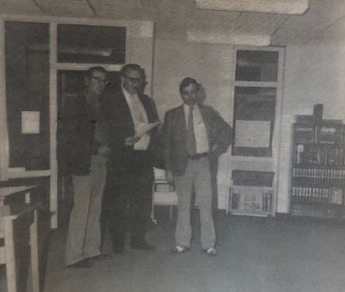

The need for yet another addition to the grade school was realized in the spring of 1971 after the ceiling fell in the 1920-1921 school which subsequently led to the structure being razed. While the addition was being constructed, kindergarten classes were held in the Girl Scout house, and provisions for other classes were made by placing some of the special areas in the gym, etc. Completed in November of ’72, the addition provided six classrooms for seventh and eighth grades, an art room, and library that was built in part of the open court area of the older part of the building. The kindergarten rooms and special education areas in the existing building were also remodeled with special education, speech therapy and counseling located in the north wing. First through third grades, fourth grade, fifth and sixth grades, as well as the seventh and eighth grades had their own wings with separate corridors for each section. With the new addition, the grade school became one of the finest in the area. Speed in the project was possible because there was enough money for the project in the district’s special building fund which eliminated the need for a bond election.
The seventh and eighth grades were moved out of the grade school when the building now known as the Academic Building was completed in 1986, and fifth and sixth graders were relocated to the current middle school at the start of the 2000-2001 school term. Since then, Lakin Grade School has served students in preschool and grades K through fourth.
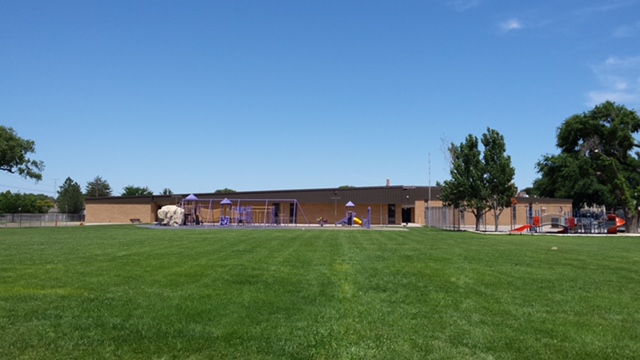
SOURCES: Lakin Independent archives; Museum archives; and information provided by the late Vernon Dietz, former superintendent of schools.
Lakin Unified School district voters rejected bond issues for new construction and remodeling of Lakin High School facilities not once, not twice, but three times in 1973 and 1974. If passed, the high school campus would look totally different than it does today. The measure would have provided for an addition to the north and west of the high school gym that would have contained girls’ physical education facilities and a new auditorium with band and vocal rooms. Also in the proposal was the addition of industrial arts facilities to the vo-ag building and remodeling of the high school to maximize space and meet fire codes. Instead, a partial remodeling project to meet fire code requirements which involved ceilings, doors, and walls in the main high school building was completed in 1975 using capital outlay money.
Still faced with overcrowding and the need for improved facilities, school officials presented two building plans to the voters in October of 1977. An overwhelming approval was given for the issuance of $1,014,580 in bonds towards a plan designed to get the utmost potential from the buildings already on site as well as new construction. The plan called for additions to the gymnasium which included a boy’s locker room and weight room, common’s/concession area, girl’s locker room, and multi-purpose rubber gym. An addition to the vocational ag building provided space for industrial arts. The interior of the main high school building was remodeled, the auditorium renovated, and new vocal and instrumental classrooms were added. When finished, the new facilities provided classroom and gymnasium space to meet the mandated requirements for Special Education and Title IX. Work began in 1978 with an anticipated finish date of January 1980 which was not met. Facilities/classrooms were moved into as they were completed, and according to the late Vernon Dietz, former superintendent of schools, the completely new and remodeled facilities were ready for the 1980-1981 school year. The work was done by L. R. Foy Construction of Hutchinson. Due to unsatisfactory work, the company was sued by USD 215. The case, argued by the late Ted Morgan, went to the Kansas Supreme Court which awarded USD 215 over $190,000 in damages.
The need for additional classroom space for the first eight grades of school became increasingly apparent in 1983 when a preschool census was taken and indicated that space would soon be a problem in the district’s elementary school. The decision was made to build a new middle school that would house 7th and 8th grades. No bond referendum was required because sufficient funds were available in the capital outlay budget of the school district, but the board elected to send a straw poll ballot to registered voters which ultimately showed that patrons were in favor of the project nearly two to one. The board accepted a negotiated contract with Rhoads Construction in the amount of $1,249,614. Ground was broken on March 28, 1985, and construction was completed the following spring.
The building, located between the gymnasium and vocational building, was constructed with a passive solar design to reduce heating and cooling costs and contained six regular classrooms, two special education classrooms, science lab, and a computer lab and art room that were utilized by both middle school and high school students. A new board of education meeting room and office space for administration were also included. The building was opened for classes in August of 1986 with an open house the following month. With the completion of the 7-8 middle school, LMS and LHS students were able to eat school lunches served in the high school’s auxiliary gymnasium instead of having to go to the grade school cafeteria. Under the satellite program, meals were prepared in the grade school’s kitchen and transferred to the gym by van. The high school’s music and band rooms, auditorium, home ec. room, library, vocation shops and gymnasium were shared with the middle school.
Increases in student population and expanded curriculum requirements for high school students in the late 1990s created a need for even more classroom space. On October 21, 1997, voters approved a $9.5 million bond issue for the construction of the current middle school complex. Ground was broken in August of 1998, and the facility was ready for grades fifth through eighth at the start of the 2000-2001 school year. The project added approximately 96,000 square feet of space to the school district and included state-of-the-art classrooms, a technology lab, modern library-media center, computer lab, music education area, prep kitchen and lunchroom/commons area, weight room and 1800-seat gymnasium. D & D Builders was the main contractor.
A new auto mechanics/welding shop was also included in the project. The 1949 vo-ag building was razed and an expanded shop facility was erected with 9,420 square feet of space for four auto bays, a welding area, and locker and restroom facilities for both boys and girls. The former 7-8 middle school was renamed the Academic Building and became part of the high school campus while still providing space for USD #215 Administrative offices and middle school art classes. A daycare for the children of USD 215 employees was housed in the building during the 2020-21 school year but was moved to the main high school building following renovations in the summer of 2021.
The final building of learning on the LHS campus is the 40×24 greenhouse made possible in with a generous donation of $30,000 from the Edgington family. In addition to providing the funding, the Rodney, Daryan and Alyssa Edgington and Kyle and Steve Berning completed the work of providing water, electricity and gas to the greenhouse. Placed on the old tennis courts behind the main building, the green house and 10 cinder-block garden plots provided by a grant from the Kearny County Wellness Coalition were ready for their first growing season in the spring of 2022. The gardens and greenhouse are part of a revival in agriculture-focused education.
Sources: Kansas Magazine; 1979 Bronc Yearbook; Archives of The Lakin Independent; Museum archives; and information provided by the late Vernon Dietz, former Superintendent of USD 215 Schools.


